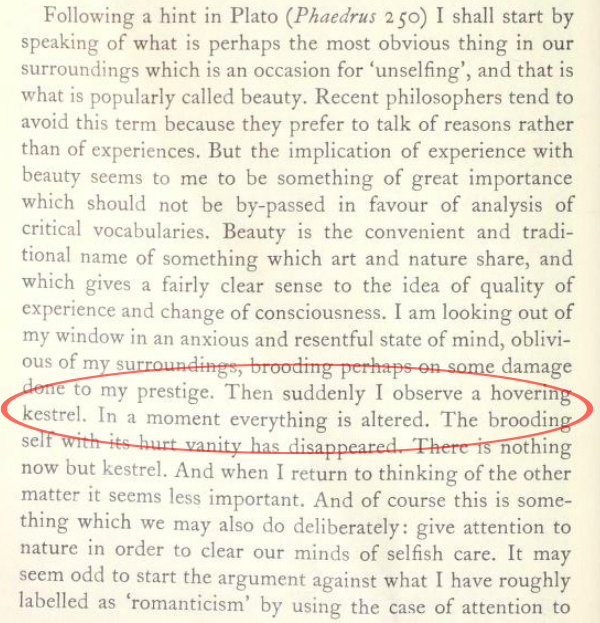A brief note from a reader:
A number of commentators have remarked on the extent to which the English moral philosopher (and novelist) Iris Murdoch centered her ethics on the notion of “Attention.” Recent work would include Anil Gomes’s 2013 article in the British Journal of Aesthetics and this essay, just published last year by Christopher Cordner. It is also a fact in evidence that those interested in durational practices of attention (in the manner of the Birds, and in other traditions) have for years read in Murdoch’s 1970 volume The Sovereignty of Good for inspiration and orientation regarding “Practical Aesthesis.”
What has not, I think, been adequately delved is the remarkable “Birdishness” of what can be read as the key passage in the whole volume, to wit, the magnificent passage on page 84 of the third chapter, “The Sovereignty of Good over Other Concepts”:
It is impossible not to be struck by the conjunction of the notions of “unselfing” and “aesthetic experience” with an encounter with an actual bird.
Which raises the question: Was Iris Murdoch a Bird? Or in some way associated with the Birds? To my knowledge, the issue has not been explored in any depth. But it is a fact worthy of consideration (and almost entirely overlooked) that Murdoch in fact authored, in 1978 an entire book of poems, each and every one of which treats of birds. The volume, known as A YEAR IN BIRDS (London: Chatto and Windus and the Hogarth Press) featured original woodcut illustrations by the artist Reynolds Stone. Much would seem to hinge on the month of August, which offers a five-line invocation of the kestrel itself, the bird we know, from Murdoch’s work on attention, figures as an allegory of that form of attention capable of transforming existence. It will be worth reproducing the verses and the woodcut, since they evidently stand at the center of a Birdish theory of attention:



